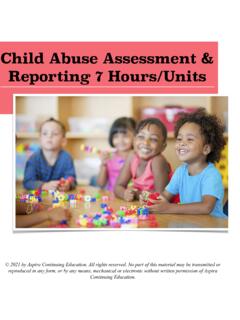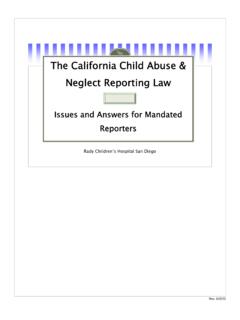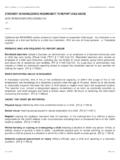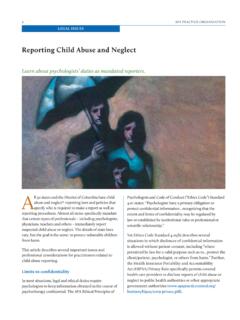Transcription of What Is Child Welfare? A Guide for Educators
1 Children s Bureau/ACYF/ | Email: | 2018 What Is Child welfare ? A Guide for EducatorsEducators make crucial contributions to the development and well-being of children and youth. Due to their close relationships with children and families, Educators can play a key role in the prevention of Child abuse and neglect and, when necessary, support children, youth, and families involved with Child welfare . This Guide for Educators provides an overview of Child welfare , describes how Educators and Child welfare workers can help each other, and lists resources for more Is Child welfare ? Child welfare is a continuum of services designed to ensure that children are safe and that families have the necessary support to care for their children successfully. Child welfare agencies typically: Support or coordinate services to prevent Child abuse and neglect Provide services to families that need help protecting and caring for their children Receive and investigate reports of possible Child abuse and neglect; assess Child and family needs, strengths, and resources Arrange for children to live with kin ( , relatives) or with foster families when safety cannot be ensured at home Support the well-being of children living with relatives or foster families, including ensuring that their educational needs are addressed Work with the children, youth, and families to achieve family reunification, adoption, or other permanent family connections for children and youth leaving foster careEach State or locality has a public Child welfare agency responsible for receiving and investigating reports of Child abuse and neglect and assessing Child and family needs; however, the Child welfare system is not a single entity.
2 Public Child welfare agencies often collaborate with private Child welfare agencies, community-based organizations, and other public agencies to ensure that families receive the services they need, such as supportive Child care, parenting classes, in-home family preservation services, mental health services, and substance abuse Is Child welfare ? A Guide for Educators2 This material may be freely reproduced and distributed. However, when doing so, please credit Child welfare Information Gateway. Available online at Can Educators Assist Child welfare Agencies and FamiliesSince Educators including teachers, administrators, counselors, school social workers, and other school personnel are regularly in close contact with children and families, they are in a unique position to support at-risk children and families; play a role in preventing Child abuse and neglect; identify and report suspected abuse or neglect; act as a liaison between the Child s home, school, and community; and be an important resource for children in foster care.
3 Supporting families and preventing Child abuse and neglect. Educators can play a significant role in preventing Child abuse and neglect and supporting children at risk for or already experiencing maltreatment . Merely being a supportive adult in a Child s life and a supportive individual/professional in a family s life can enhance the Child s resiliency. Educators can help Guide parents in times of crisis, teach and model positive discipline practices, and refer children and families for additional services and supports, if needed, which may prevent referrals to out-of-home care. Additionally, Educators can help families become more involved in school activities and also encourage families to engage with Child welfare when indicated. Identifying possible abuse and neglect. Educators also should be aware of the types of Child maltreatment , including neglect, physical abuse , sexual abuse , and emotional abuse ; their possible physical, emotional, and behavioral signs; and State definitions about what constitutes Child maltreatment .
4 For more information on each State s definition of Child maltreatment , refer to Child welfare Information Gateway s Definitions of Child abuse and Neglect, available at Reporting suspected Child abuse and neglect. In 2016, percent of all Child abuse and neglect reports were made by Educators , followed by legal and law enforcement personnel ( percent).1 Educators should be knowledgeable about the Child maltreatment reporting protocols for their particular schools and localities. All States designate teachers as mandatory reporters, which means they are required by law to report suspected Child abuse and neglect to the appropriate Child welfare agency. Other school employees also may be mandatory reporters, but that designation varies by State. For more information on laws that designate the groups of individuals that are required to report cases of suspected Child abuse and neglect, see Mandatory Reporters of Child abuse and Neglect: Summary of State Laws, available at Being a resource for Child welfare agencies.
5 Child welfare workers frequently consult with school personnel when assessing a family, developing a case plan, and determining where the Child should live. Educators may have information (either in records or through personal knowledge) about the Child s or family s strengths and challenges. This information is invaluable to caseworkers as they assess and work with the family to formulate realistic goals. Additionally, when a Child changes schools, Educators can support a smooth transition by facilitating the timely transfer of records. Read more about how the Child welfare system and Educators can work together in Educator s Guide to Supporting Students in Foster Care, available at Being a resource for children involved with Child welfare . Children involved in a Child protective services investigation or living in out-of-home care ( , with relatives or a foster family) need the stability of normal experiences, such as attending school and being involved in extracurricular activities.
6 Children who have changed schools a number of times may need extra help in making up schoolwork, earning credits, or filling in gaps in their learning. They also may need support or encouragement to participate in extracurricular activities such as sports, music, drama, and club. These can have a positive effect on their attendance, academic work, behavior, self-confidence, and ability to make friends. Additionally, Educators can assist by learning more about policies and 1 Department of Health and Human Services, Children s Bureau. (2017). Child maltreatment 2016. Retrieved from Is Child welfare ? A Guide for Educators3 This material may be freely reproduced and distributed. However, when doing so, please credit Child welfare Information Gateway. Available online at that are applicable to children involved with Child welfare , such as eligibility for services, scholarship and financial aid opportunities, and confidentiality issues. Furthermore, children involved with Child welfare often have experienced various forms of trauma ( , abuse , neglect, removal from the home), and Educators can support them by recognizing the effects of trauma and utilizing trauma-informed practices.
7 How Can Child welfare Workers Assist Educators ? Collaboration between the education and Child welfare systems can assist Educators by: Ensuring that children are ready to learn. Children who have experienced abuse or neglect may have cognitive difficulties or developmental delays, and they may perform below their peers in school. Child welfare workers can help ensure that children and families receive the services and supports they need, including access to early intervention, special education, mental and behavioral health, and prevention services. These services and supports can build resiliency to reduce the effects of previous maltreatment , thereby improving children s school readiness and overall well-being. Keeping children in their home schools. When students are able to remain in the same school, they remain connected to friends and adults in the school and avoid the academic and emotional challenges that can be caused by changing schools. This prevents disruption in their education, eases their transition to a new living arrangement, and ensures that previous community supports are still in place.
8 The Fostering Connections to Success and Increasing Adoptions Act of 2008 (the Fostering Connections Act) requires that Child welfare workers try to place children with relatives or others in their community in order to minimize school moves. In certain cases, the Fostering Connections Act permits Child welfare agencies to use funds to provide transportation to support school stability. If a Child must move to a new school, Fostering Connections requires Child welfare workers to coordinate with schools to ensure a smooth transition. In addition, the Every Student Succeeds Act (ESSA) of 2015 includes provisions that promote educational stability for children in foster care so they can continue their education without disruption, maintain important peer and teacher relationships, and have the opportunity to achieve college and career readiness. The act also emphasizes the importance of collaboration and joint decision-making between Child welfare agencies and educational agencies. To learn more about ESSA and to find a listing of adaptable tools and resources for States, visit Making Educators aware of a Child s situation and involvement in the Child welfare system.
9 When a student enters out-of-home care or changes placement, the Fostering Connections Act and ESSA require Child welfare and education agencies to collaborate to determine whether it is in the Child s best interest to remain in their school of origin. However, if a Child is part of a Child protective services case or is involved in in-home services, schools are not always notified and made aware of the situation. Read more about education stability at Inviting Educators to participate in a multidisciplinary team. Child welfare workers can assist Educators and support school success by being active participants in individualized education program (IEP) team meetings, school discipline meetings, and transition meetings to discuss a Child s postsecondary goals. Given their strong connection to the Child and family, Educators are in a unique position to provide their expertise at multidisciplinary team meetings arranged by Child welfare workers. These meetings bring together family members and professionals to discuss the Child s and family s needs and develop a case plan that supports both.
10 Coordinating Child welfare and education plans and ensuring the appropriate individuals are involved helps improve outcomes for children and families. Child welfare laws make it mandatory for Child welfare agencies to maintain education records as a part of a Child s case plan; therefore, the passing of the Uninterrupted Scholars Act of 2013 makes it possible for Child welfare Department of Health and Human Services Administration for Children and Families Administration on Children, Youth and Families Children s Is Child welfare ? A Guide for Educatorsagencies to obtain the education records of children in foster care from schools without the consent of their parents. This alleviates any delays in enrolling children in school and ensures that their school placements are as stable as possible, and they are enrolled with all their school records. Read more about the Uninterrupted Scholars Act in The Uninterrupted Scholars Act: How Do Recent Changes to FERPA Help Child welfare Agencies Access School Records?














